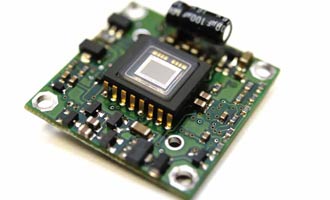When selecting an image sensor, the primary factor for most camera makers is image quality, Karunakaran said. “Key performance specifications for surveillance applications include low light sensitivity, noise performance and dynamic range — cameras that need to successfully accommodate high dynamic range scenes require a specialized WDR sensor.”
 Image quality is one of the main criteria for sensor selection. “But it also depends on where the camera is deployed,” said Johan Paulsson, CTO of Axis Communications.
Image quality is one of the main criteria for sensor selection. “But it also depends on where the camera is deployed,” said Johan Paulsson, CTO of Axis Communications.
Another decisive factor is a dependable supply chain. “As a result of lacking a steady supply chain, you can find yourself in a situation where you have enough DSPs but not enough sensors, making it hard to provide reliable service to your costumers,” said Gregor Schnitzler, Technical Director for ABUS Security-Center.
While CCD sensors have traditionally performed better in low-light conditions, CMOS sensors are narrowing that gap. “Recent technology advancements have eradicated the difference in light sensitivity between a CCD and CMOS sensor at a given price point,” according to research done by Axis.
Furthermore, CMOS technology enables various camera functions to be integrated onto the same chip, whereas multichip solutions for CCDs can be more expensive and bulkier. The CMOS sensor could also integrate image sensor processor (ISP) functionality, which allows camera makers to reduce the number of chips in their network camera design, Karunakaran said. “Some network cameras employ RAW sensors and have ISP functions handled externally.”
CCD and CMOS sensors each have unique advantages, yet traditional stereotypes may not be as accurate as they once were. The best strategy for a camera manufacturer is to continually evaluate and test sensors for each and every camera that is developed, according to Axis Communications in a technical paper. “The question whether a chosen sensor is based on CCD or CMOS technology then becomes irrelevant. The only focus is if the sensor can be used to build a network camera which delivers the image quality needed and fulfills the customers' video surveillance requirements.”
 Processing Images
Processing Images
The information captured by the image sensor goes through several stages of processing. Adoption of HD content places demands on all aspects of a surveillance system. “Whether it's the increased processing required to perform image signal processing and enhancements or the latest generation of compression CODECs to squeeze the high resolution video down a limited bandwidth pipe,” said Mark Oliver, Director of Product Marketing for Stretch, “one constant in the equation is an increased demand for processing.”
With innovative solutions based on ARM and MIPS architecture, processors for embedded systems are becoming increasingly powerful, while decreasing in size and power consumption. Image processing functions for surveillance cameras have traditionally resided on a dedicated DSP chip; many vendors now integrate them onto the same chip as the sensor.